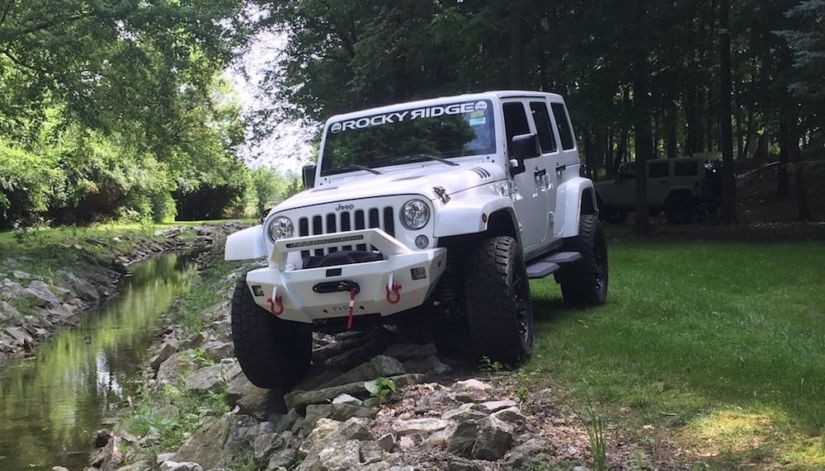“That is the question…”
Okay, it’s hardly Shakespeare but, then again, it’s hardly a question. Few Jeep drivers (if any) have not considered modifying their Jeep with a raised suspension or oversized tires. A common consideration for many off-road vehicles, it’s sort of an inevitability when you’re talking about a Jeep. Whether the lift is being considered for form or function is beside the point. If you meet someone who buys a Jeep with a factory / stock suspension, and wants to drive it “as is,” just walk away. You don’t need that kind of negativity in your life.
Just kidding…(I guess…)
But what if you’re only in the shopping stage. Do you buy a jeep and mod it up, yourself? Or do you actually start searching for lifted Jeeps ready to roll? Who’s to say? Either way, you have homework to do. Whether you’re looking to fit your own lift kit to a stock Jeep or buy one that’s been pre-lifted, it’s important to understand what you’re getting into.
Well, Lifted Vehicles Are Dangerous
We’ve all heard this before…
Yes, a lifted vehicle is more susceptible to rollover. Yes, a lifted vehicle could cause more damage in rear-end accidents due to its raised bumper level. Yes, a lift can impact driver visibility. Yes, a lift can position headlights in a manner distracting to other drivers. Yes, the high center of gravity can affect overall handling, braking, and navigation. Blah, Blah, Blah.
But seriously, a minivan can be a death machine if an idiot is behind the wheel. Hell, even pizza can be dangerous, hot out of the oven, in the hands of a moron. As with any risk, the burden rests on the shoulders of the operator. If you perform your due diligence, find the right marriage of vehicle and kit, and drive with half a brain in your head, you’ll be fine.
Know Your Driving
How and where do you drive? More importantly, how and where do you plan to drive in the lifted vehicle?
If you just want the lift for the looks and aren’t really in the market for adventure…well, enjoy your life on pavement and those Friday night meet-ups in the mall parking lot. A budget kit and stock gears are likely to suit all your needs.
If your purchase is inspired by plans to hit the trails and kick some mud up, you’re going to want to increase your ground clearance, make sure the Jeep has the right suspension, and consider larger performance-designed tires suitable for the various terrains that you plan to conquer.
If your plans fall exclusively into one category, or the other, your mod is going to be a lot easier to figure out. You don’t have to be concerned about sacrificing the Jeep’s speed-handling in order to get the best suspension articulation. But the vast majority of Jeep drivers are looking for the best of both worlds: half daily-driver, half weekend tank. Balance of the two calls for a marriage of on-road drivability and the flexibility of an off-road suspension.
If you’re buying a pre-lifted Jeep, make sure that you understand what you’re buying to make sure the vehicle was properly modded. And if you’re planning to do the work yourself…
Know Your Skill Level
Lifting any vehicle is not for rank amateurs. So unless you’re a competent mechanic, with the proper skill level and tools, entrust a more experienced professional to install the lift. This isn’t a project that you want to gamble with, based on a YouTube tutorial and a dream. If you want it done right, and are unsure of your ability to do so, set your ego aside. The life of your vehicle, and of your passengers, may depend on it.
Know Your Limitations
Every state has its own laws and regulations on the legality of lifted vehicles. The last thing you want to do is install a 4-inch lift, invest in 37” tires and get pulled over by the cops as soon as you pull out of your driveway. Smarten up. Know what restrictions you face, based on your geography.
Know Your Geometry
Depending on your selection of lift and/or tires, you will need to consider your Jeep’s geometry. If you’re planning to rock a more modest lift on 33-inch tires or smaller, you may not need anything more than a 1.5-inch Budget Boost to get the fender clearance required. This will consist of both Spring and Shock spacers for the front and rear, longer front sway bar links, and brake line extensions for both the front and rear.
A 2.5 to 3.5-inch lift goes hand-in-hand with 33 to 35-inch tires. In addition to the standard components listed above, you should also expect to install front and rear track bars, as well as upper or lower front control arms. These will be needed to realign the front axle.
If you plan on even bigger tires, plan on a 4+inch lift kit. Also plan on replacing most of the stock suspension, installing a new drive shaft, realigning the geometry, and re-centering the axle.
Just remember that if you’re lifting your jeep over 2 to 3-inches, you’ll need to counter driveline vibration. At minimum, it will wear out your U-joints faster. At maximum, your rear driveshaft could find its way out of the transfer case. Plan to add a slip yoke eliminator, and install a CV driveshaft. And if your lift nets more than a 4-inch gain, plan to replace your driveshaft altogether.
Know What’s Right For You
Bottom-line, you need to do what’s right for you. No one is going to ban you from doing the ‘Jeep Wave’ for choosing a more conservative lift, as long as you know your Jeep’s limitations. On the other hand, you’re only limited by available parts and the long arm of the law.
Just take the steps to make sure that your lifted Jeep is properly configured for safety, and for whatever you plan to throw at it.



